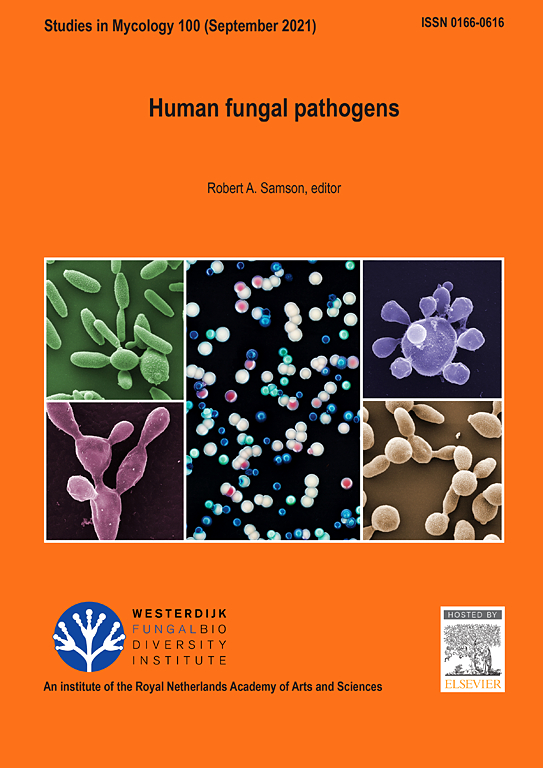Chaetosphaeriales和Vermiculariopsiellales中具有类似氯化物形态的新属和新种。
摘要
在本研究中,我们调查了属于狭叶绿球藻属(Chloridium sensu lato)的部分物种的形态和遗传变异性,其中一些物种也被称为绿球藻类无性形态和其他未被描述的形态相似的真菌。这些物种不符合修订后的属概念,因此有必要在分类学和系统发育方面进行重新评估。Chaetosphaeriaceae(Chaetosphaeriales)科包括多种无性形态,其中最简单的形态以 Chloridium sect.Chloridium 科。Chloridium 形态的简单性在历史上导致了许多不相关物种的合并,从而形成了一个异质的属。通过对四个 DNA 位点进行系统发育重建,并对 71 个菌株(包括所有可用的外型菌株和其他非外型菌株以及全型和其他标本馆材料)进行研究,我们对这些类群之间的关系有了新的认识。系统发育分析表明,所研究的物种与严格意义上的 Chloridium 亲缘关系较远,可归入脊索真菌纲的两个目。在Chaetosphaeriales中,它们在4个支系中形成了9个分离良好的属,如Cacumisporium、Caliciastrum gen.我们还在 Vermiculariopsiellales 中建立了 Chloridiopsiella gen.在这些属中提出了 4 个新种和 8 个新组合。我们的研究使人们更清楚地了解了绿僵菌属(Chloridium)及其与其他形态上相似的真菌的关系,并提供了一种新的分类学处理方法和分子系统发育方法,以便在今后的研究中对其进行准确的鉴定和分类。分类学上的新发现:新属Caliciastrum Réblová、Caligospora Réblová、Capillisphaeria Réblová、Chloridiopsiella Réblová、Chloridiopsis Réblová、Geniculoseta Réblová、Papillospora Réblová、Spicatispora Réblová;新种:Caliciastrum bicolor Réblová,Caligospora pannosa Réblová,Chloridiopsis syzygii Réblová,Gongromerizella silvana Réblová;新组合:Caligospora dilabens (Réblová & W. Gams) Réblová, Capillisphaeria crustacea (Sacc.) Réblová, Chloridiopsiella preussii (W. Gams & Hol.-Jech.) Réblová, Chloridiopsis constrictospora (Crous et al.) Réblová, Geniculoseta preussii (W. Gams & Hol.Jech.) Réblová, Papillospora hebetiseta (Réblová & W. Gams) Réblová, Spicatispora carpatica (Hol.-Jech. & Révay) Réblová, Spicatispora fennica (P. Karst.) Réblová; Epitypifications (basionyms):Chaetosphaeria dilabens Réblová & W. Gams, Chloridium cylindrosporum W. Gams & Hol.-Jech.Citation:Réblová M, Nekvindová J (2023).Chaetosphaeriales 和 Vermiculariopsiellales 中具有类似绿藻形态的新属和新种。Doi: 10.3114/sim.2023.106.04.In this study, we investigated the morphological and genetic variability of selected species belonging to the genus Chloridium sensu lato, some also referred to as chloridium-like asexual morphs and other undescribed morphologically similar fungi. These species do not conform to the revised generic concept and thus necessitate a re-evaluation in terms of taxonomy and phylogeny. The family Chaetosphaeriaceae (Chaetosphaeriales) encompasses a wide range of asexual morphotypes, and among them, the simplest form is represented by Chloridium sect. Chloridium. The morphological simplicity of the Chloridium morphotype has historically led to the amalgamation of numerous unrelated species, thereby creating a heterogeneous genus. By conducting phylogenetic reconstruction of four DNA loci and examining a set of 71 strains, including all available ex-type and other non-type strains as well as holotypes and other herbarium material, we were able to gain new insights into the relationships between these taxa. Phylogenetic analyses revealed that the studied species are distantly related to Chloridium sensu stricto and can be grouped into two orders in the Sordariomycetes. Within the Chaetosphaeriales, they formed nine well-separated genera in four clades, such as Cacumisporium, Caliciastrum gen. nov., Caligospora gen. nov., Capillisphaeria gen. nov., Curvichaeta, Fusichloridium, Geniculoseta gen. nov., Papillospora gen. nov., and Spicatispora gen. nov. We also established Chloridiopsiella gen. nov. and Chloridiopsis gen. nov. in Vermiculariopsiellales. Four new species and eight new combinations are proposed in these genera. Our study provides a clearer understanding of the genus Chloridium, its relationship to other morphologically similar fungi, and a new taxonomic treatment and molecular phylogeny to facilitate their accurate identification and classification in future research. Taxonomic novelties: New genera: Caliciastrum Réblová, Caligospora Réblová, Capillisphaeria Réblová, Chloridiopsiella Réblová, Chloridiopsis Réblová, Geniculoseta Réblová, Papillospora Réblová, Spicatispora Réblová; New species: Caliciastrum bicolor Réblová, Caligospora pannosa Réblová, Chloridiopsis syzygii Réblová, Gongromerizella silvana Réblová; New combinations: Caligospora dilabens (Réblová & W. Gams) Réblová, Capillisphaeria crustacea (Sacc.) Réblová, Chloridiopsiella preussii (W. Gams & Hol.-Jech.) Réblová, Chloridiopsis constrictospora (Crous et al.) Réblová, Geniculoseta preussii (W. Gams & Hol.-Jech.) Réblová, Papillospora hebetiseta (Réblová & W. Gams) Réblová, Spicatispora carpatica (Hol.-Jech. & Révay) Réblová, Spicatispora fennica (P. Karst.) Réblová; Epitypifications (basionyms): Chaetosphaeria dilabens Réblová & W. Gams, Chloridium cylindrosporum W. Gams & Hol.-Jech. Citation: Réblová M, Nekvindová J (2023). New genera and species with chloridium-like morphotype in the Chaetosphaeriales and Vermiculariopsiellales. Studies in Mycology 106: 199-258. doi: 10.3114/sim.2023.106.04.

 求助内容:
求助内容: 应助结果提醒方式:
应助结果提醒方式:


